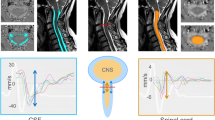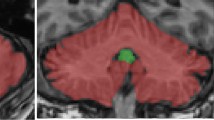Abstract
Background
Progressive supranuclear palsy (PSP) patients can show ventricular enlargement mimicking normal pressure hydrocephalus (NPH). The aim of this study was to distinguish PSP patients with marked ventricular dilatation (PSP-vd) from those with normal ventricular system and to evaluate the coexistence of NPH in PSP-vd patients.
Methods
One hundred three probable PSP patients, 18 definite NPH patients, and 41 control subjects were enrolled in the study. Evans index (EI) > 0.32 associated with callosal angle (CA) < 100° was used to identify PSP-vd patients. Automated ventricular volumetry (AVV) and Magnetic Resonance Hydrocephalic Index (MRHI) were performed on T1-weighted MR images to evaluate the presence of NPH in PSP-vd patients.
Results
Twelve (11.6%) out of 103 PSP patients had both abnormal EI and CA values (PSP-vd). In two of these 12 patients, AVV and MRHI values suggested PSP + NPH. In the remaining 10 PSP-vd patients, AVV and MRHI values were higher than PSP patients with normal ventricular system and controls, but lower than PSP + NPH and NPH patients, suggesting a non-hydrocephalic ventricular enlargement.
Discussion
Our study provides evidence that the combination of EI and CA biomarkers allowed to identify PSP patients with marked ventricular dilatation mimicking NPH. Only a few of these patients had PSP + NPH. Recognition of these PSP patients with enlarged ventricles can positively impact the care of this disease, helping clinicians to identify patients with PSP + NPH who could benefit from shunt procedure and avoid surgery in those with enlarged ventricles without NPH.


Similar content being viewed by others
Data availability
The data that support the findings of this study are available on request from the corresponding author. The data are not publicly available due to privacy or ethical restrictions.
Code availability
Not applicable.
References
Höglinger GU, Respondek G, Stamelou M, Kurz C, Josephs KA, Lang AE, Mollenhauer B, Müller U, Nilsson C, Whitwell JL, Arzberger T, Englund E, Gelpi E, Giese A, Irwin DJ, Meissner WG, Pantelyat A, Rajput A, van Swieten JC, Troakes C, Antonini A, Bhatia KP, Bordelon Y, Compta Y, Corvol JC, Colosimo C, Dickson DW, Dodel R, Ferguson L, Grossman M, Kassubek J, Krismer F, Levin J, Lorenzl S, Morris HR, Nestor P, Oertel WH, Poewe W, Rabinovici G, Rowe JB, Schellenberg GD, Seppi K, van Eimeren T, Wenning GK, Boxer AL, Golbe LI, Litvan I, for the Movement Disorder Society- endorsed PSP study group (2017) Clinical diagnosis of progressive supranuclear palsy: the Movement Disorder Society criteria. Mov Disord 6:853–864
Kato N, Arai K, Hattori T (2003) Study of the rostral midbrain atrophy in progressive supranuclear palsy. J Neurol Sci 210:57–60
Quattrone A, Antonini A, Vaillancourt DE, Seppi K, Ceravolo R, Strafella AP, Morelli M, Nigro S, Vescio B, Bianco MG, Vasta R, Arcuri PP, Weis L, Fiorenzato E, Biundo R, Burciu RG, Krismer F, McFarland NR, Mueller C, Gizewski ER, Cosottini M, Del Prete E, Mazzucchi S, Quattrone A (2020) A new MRI measure to early differentiate progressive supranuclear palsy from de novo Parkinson’s disease in clinical practice: an international study. Mov Disord 36(3):681–689. https://doi.org/10.1002/mds.28364
Ohara M, Hattori T, Yokota T (2020) Progressive supranuclear palsy often develops idiopathic normal pressure hydrocephalus-like MRI features. Eur J Neurol 27:1930–1936
Quattrone A, Sarica A, La Torre D, Morelli M, Vescio B, Nigro S, Barbagallo G, Nisticò R, Salsone M, Arcuri PP, Novellino F, Bianco MG, Arabia G, Cascini G, Quattrone A (2020) Magnetic resonance imaging biomarkers distinguish normal pressure hydrocephalus from progressive supranuclear palsy. Mov Disord 35:1406–1415
Cucca A, Biagioni MC, Sharma K, Golomb J, Gilbert RM, Di Rocco A, Fleisher JE (2018) Comorbid normal pressure hydrocephalus with parkinsonism: a clinical challenge and call for awareness. Case Rep Neurol Med 21:2513474
Lee JY, Im K, Kwon KY (2018) Parkinsonian patient with comorbid normal pressure hydrocephalus : clinical usefulness of diagnosis supported by neurological findings. Clin Neuroradiol 28:617–618
Schott JM, Williams DR, Butterworth RJ, Janssen JC, Larner AJ, Holton JL, Rossor MN (2007) Shunt responsive progressive supranuclear palsy? Mov Disord 30:902–903
Starr BW, Hagen MC, Espay AJ (2014) Hydrocephalic Parkinsonism: lessons from normal pressure hydrocephalus mimics. J Clin Mov Disord 29:1–2
Magdalinou NK, Ling H, Smith JD, Schott JM, Watkins LD, Lees AJ (2013) Normal pressure hydrocephalus or progressive supranuclear palsy? A clinicopathological case series. J Neurol 260:1009–1013
Espay AJ, Da Prat GA, Dwivedi AK, Rodriguez-Porcel F, Vaughan JE, Rosso M, Devoto JL, Duker AP, Masellis M, Smith CD, Mandybur GT, Merola A, A.E., Lang, (2017) Deconstructing normal pressure hydrocephalus: Ventriculomegaly as early sign of neurodegeneration. Ann Neurol 82:503–513
Mori E, Ishikawa M, Kato T, Kazui H, Miyake H, Miyajima M, Nakajima M, Hashimoto M, Kuriyama N, Tokuda T, Ishii K, Kaijima M, Hirata Y, Saito M, Arai H, Japanese Society of Normal Pressure Hydrocephalus (2012) Guidelines for management of idiopathic normal pressure hydrocephalus: second edition. Neurol Med Chir (Tokyo) 52:775–809
Litvan I, Agid Y, Calne D, Campbell G, Dubois B, Duvoisin RC, Goetz CG, Golbe LI, Grafman J, Growdon JH, Hallett M, Jankovic J, Quinn NP, Tolosa E, Zee DS (1996) Clinical research criteria for the diagnosis of progressive supranuclear palsy (Steele-Richardson-Olszewski syndrome): report of the NINDS-SPSP international workshop. Neurology 47:1–9
Williams DR, de Silva R, Paviour DC, Pittman A, Watt HC, Kilford L, Holton JL, Revesz T, Lees AJ (2005) Characteristics of two distinct clinical phenotypes in pathologically proven progressive supranuclear palsy: Richardson’s syndrome and PSP-parkinsonism. Brain 128:1247–1258
Miskin N, Patel H, Franceschi AM, Ades-Aron B, Le A, Damadian BE, Stanton C, Serulle Y, Golomb J, Gonen O, Rusinek H, George AE, Alzheimer’s disease neuroimaging initiative (2017) Diagnosis of normal-pressure hydrocephalus: use of traditional measures in the era of volumetric MR imaging. Radiology 285:197–205
Fahn S, Elton RL (1987) Unified Parkinson’s Disease Rating Scale. In: Fahn S, Marsden CD, Calne D, Goldstein M (eds) Recent developments in Parkinson’s disease. MacMillan Healthcare Information, Florham Park, pp 153–163
Folstein MF, Folstein SE, McHugh PR (1975) “Mini-mental state:” A practical method for grading the cognitive state of patients for the clinician. J Psychiatr Res 12:189–198
Kubo Y, Kazui H, Yoshida T, Kito Y, Kimura N, Tokunaga H, Ogino A, Miyake H, Ishikawa M, Takeda M (2008) Validation of grading scale for evaluating symptoms of idiopathic normal-pressure hydrocephalus. Dement Geriatr Cogn Disord 25:37–45
Appollonio I, Leone M, Isella V, Piamarta F, Consoli T et al (2005) The frontal assessment battery (FAB): normative values in an Italian population sample. Neurol Sci 26:108–116. https://doi.org/10.1007/s10072-005-0443-4
Wechsler D (1981) Manual for the Wechsler Adult Intelligence Scale Revised. Psychological Corporation, New York
Carlesimo GA, Caltagirone C, Gainotti G (1996) The mental deterioration battery: normative data, diagnostic reliability and qualitative analyses of cognitive impairment. The Group for the Standardization of the Mental Deterioration Battery. Eur Neurol 36:378–84. https://doi.org/10.1159/000117297
Benton AL, Varney NR, Hamsher KD (1978) Visuospatial judgment. A clinical test. Arch Neurol 35:364–367. https://doi.org/10.1001/archneur.1978.00500300038006
(1987) Italian standardization and classification of Neuropsychological tests. The Italian Group on the Neuropsychological Study of Aging. Ital J Neurol Sci Suppl 8:1–120
Ishii K, Kanda T, Harada A, Miyamoto N, Kawaguchi T, Shimada K, Ohkawa S, Uemura T, Yoshikawa T, Mori E (2008) Clinical impact of the callosal angle in the diagnosis of idiopathic normal pressure hydrocephalus. Eur Radiol 18:2678–2683
Dale AM, Fischl B, Sereno MI (1999) Cortical surface-based analysis. I. Segmentation and surface reconstruction. Neuroimage 9:179–194
Ishii K, Soma T, Shimada K, Oda H, Terashima A, Kawasaki R (2013) Automatic volumetry of the cerebrospinal fluid space in idiopathic normal pressure hydrocephalus. Dement Geriatr Cogn Dis Extra 3:489–496
Marmarou A, Bergsneider M, Klinge P, Relkin N, Black PM (2005) The value of supplemental prognostic tests for the preoperative assessment of idiopathic normal-pressure hydrocephalus. Neurosurgery 57:S17-28. https://doi.org/10.1227/01.neu.0000168184.01002.60 (discussion ii-v)
Mihalj M, Dolić K, Kolić K, Ledenko V (2016) CSF tap test - Obsolete or appropriate test for predicting shunt responsiveness? A systemic review. J Neurol Sci 362:78–84. https://doi.org/10.1016/j.jns.2016.01.028
Ali F, Martin PR, Botha H, Ahlskog JE, Bower JH, Masumoto JY, Maraganore D, Hassan A, Eggers S, Boeve BF, Knopman DS, Drubach D, Petersen RC, Dunkley ED, van Gerpen J, Uitti R, Whitwell JL, Dickson DW, Josephs KA (2019) Sensitivity and specificity of diagnostic criteria for progressive supranuclear palsy. Mov Disord 34:1144–1153
Author information
Authors and Affiliations
Contributions
Andrea Quattrone and Aldo Quattrone contributed to the study conception and design. All authors contributed to the data collection and analysis. The first draft of the manuscript was written by Andrea Quattrone. All authors revised the article critically for intellectual content and approved the final version of the manuscript to be submitted.
Corresponding author
Ethics declarations
Ethics approval
This study was performed in line with the principles of the Declaration of Helsinki. All study procedures and ethical aspects were approved by the institutional review board of Magna Graecia University, Catanzaro, Italy.
Consent to participate
Written informed consent was obtained from each participant included in the study.
Consent for publication
All authors have approved the manuscript before submission, including the names and order of authors; all gave explicit consent to submit and they obtained consent from the responsible authorities at the institute/organization where the work has been carried out.
Conflict of interest
The authors declare no competing interests.
Additional information
Publisher's note
Springer Nature remains neutral with regard to jurisdictional claims in published maps and institutional affiliations.
Rights and permissions
About this article
Cite this article
Quattrone, A., Sarica, A., La Torre, D. et al. Progressive supranuclear palsy with marked ventricular dilatation mimicking normal pressure hydrocephalus. Neurol Sci 43, 1783–1790 (2022). https://doi.org/10.1007/s10072-021-05594-4
Received:
Accepted:
Published:
Issue Date:
DOI: https://doi.org/10.1007/s10072-021-05594-4




